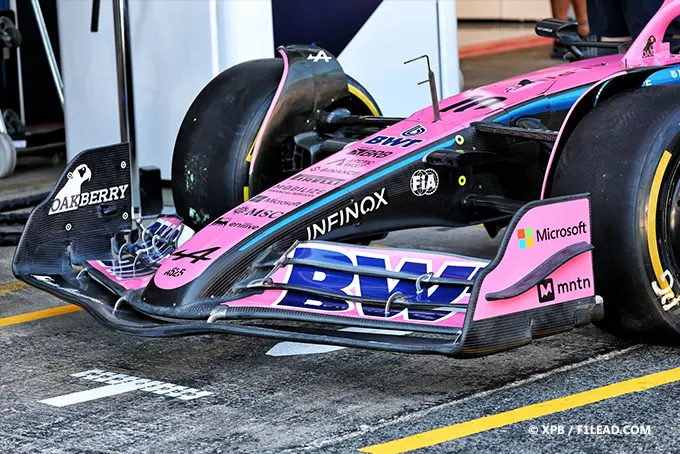With title tensions rising, the FIA tightens flex tests in Spain—aiming to curb aero tricks and restore competitive fairness.
Starting this weekend in Barcelona, the FIA will enforce stricter tests on front wings, following the model of tighter rear wing tests introduced in China and Japan.
Nikolas Tombazis, FIA’s Single-Seater Director, explains the reasoning behind these changes and their implications for the future.
This weekend, the FIA is further tightening the load tests applied to F1 wings to address concerns about flexibility and the performance gains teams might extract from wings that bend under load.
Stricter Aero Tests Incoming
Ahead of the 2025 season, the Federation announced that, in response to concerns raised throughout 2024 about teams seeking designs that could reduce drag at high speed or even alter the aerodynamic balance of the car from low to high speed, it would introduce new or more demanding load-deflection tests for the front wing at the Spanish Grand Prix, as well as the upper rear wing and the rear beam wing.
As Tombazis explains, “When the championship battles intensify, teams tend to scrutinize each other’s cars more closely, which naturally raises concerns. During the second half of last season, we concluded that further tightening of the tests for 2025 was necessary.”
Rear wing deformation was initially addressed by the 2025 regulations, with Article 3.15.17 specifying that if a vertical load of 75 kg is applied to either end of the main rear wing plane, the distance between the main plane and the flap (also known as “slot gap”) must not vary by more than 2 mm.
- Discover More>F1’s 2026 Plan to Seal Budget Cap Loopholes
Delayed Front Wing Crackdown
“The 2025 regulations were designed to counter the mini-DRS effect, which became a significant discussion point last autumn,” explains Tombazis, referring to concerns about rear wing flexing and the appearance of a drag-reducing gap between wing elements under load. “This test was applied from the start of the season, but it quickly became clear it was insufficient.”
To assess the effectiveness of the regulation, cameras were installed on cars during the free practice sessions at the Australian Grand Prix, which opened the season. After analyzing the footage, the FIA concluded that even more stringent tests were needed. At the Chinese Grand Prix, the tolerance was reduced to 0.75 mm, and at the following race in Japan, it was lowered to 0.5 mm.
With the rear wing flexing addressed, attention now turns to the front wings. But why only starting this weekend?
“At several races, during and after the 2024 Belgian Grand Prix, we fitted cameras on the front wings of all cars and, once again, concluded that the tests needed to be strengthened. However, this conclusion came quite late in the year, and we felt that introducing additional tests at the start of the season would have been difficult for teams and could have forced the withdrawal of existing front wings, leading to additional costs. As a result, we believed a delayed introduction was more sensible.”
Front Wing Flex Tightened
The parameters of these stricter tests are defined in the revisions to Articles 3.15.4 and 3.15.5 of the 2025 Technical Regulations, which govern the flexibility of the front wing bodywork and front wing flaps, respectively.
The initial regulation stated that when a 100 kg load is applied symmetrically on both sides of the car, vertical deflection must not exceed 15 mm, and when applied to one side only, it must not exceed 20 mm.
However, starting this weekend, when the load is applied symmetrically, vertical deflection must not exceed 10 mm, and when applied asymmetrically, it must not exceed 15 mm.
Regarding the flexibility of the front wing flaps, the regulation previously stipulated that “any part of the trailing edge of a front wing flap must not deflect by more than 5 mm, measured along the load axis, when a 6 kg point load is applied perpendicularly to the flap.” As of this weekend, the permitted deflection is reduced to just 3 mm.
While these reductions may appear minimal, the increase in rigidity is significant and, according to Tombazis, the issue will be resolved for the remainder of the year.
“It is obviously legitimate for the FIA to introduce flexibility or rigidity tests when it deems an area to be overly exploited, but we hope this will be the last time this year.”
FIA Ramps Up Testing
To ensure this, component tests are conducted regularly.
“We check teams at different points in the season and ask them to bring specific components. We examine them separately, or on the entire car. We often conduct tests in parc fermé, either on Saturday after qualifying or on Sunday morning, because teams obviously cannot change their car in parc fermé. This ensures they don’t fit a stiff wing for practice and use something else in the race. Occasionally, we also perform checks after a race if we deem it necessary. These tests are static load tests as defined in Article 3.15 of the Technical Regulations.”
With new regulations coming into force in 2026, it is expected that component flexibility issues will decrease. However, Tombazis asserts that in a sport where technical ingenuity reigns, the FIA will continue testing problematic areas.
“There are areas where the trend of using flexible components is less prevalent, especially due to the straight-line mode in 2026. Therefore, in some areas, we may decide to ease the testing stringency. But fundamentally, the philosophy remains the same. We must stay vigilant and continue testing. In fact, we are currently defining the loads for next year. We’ll see how the first phase develops and, if necessary, we’ll respond to preserve fairness.”
- Discover More>Steel replaces titanium in F1 test to stop grass fires
- Following us on>Facebook et Twitter
